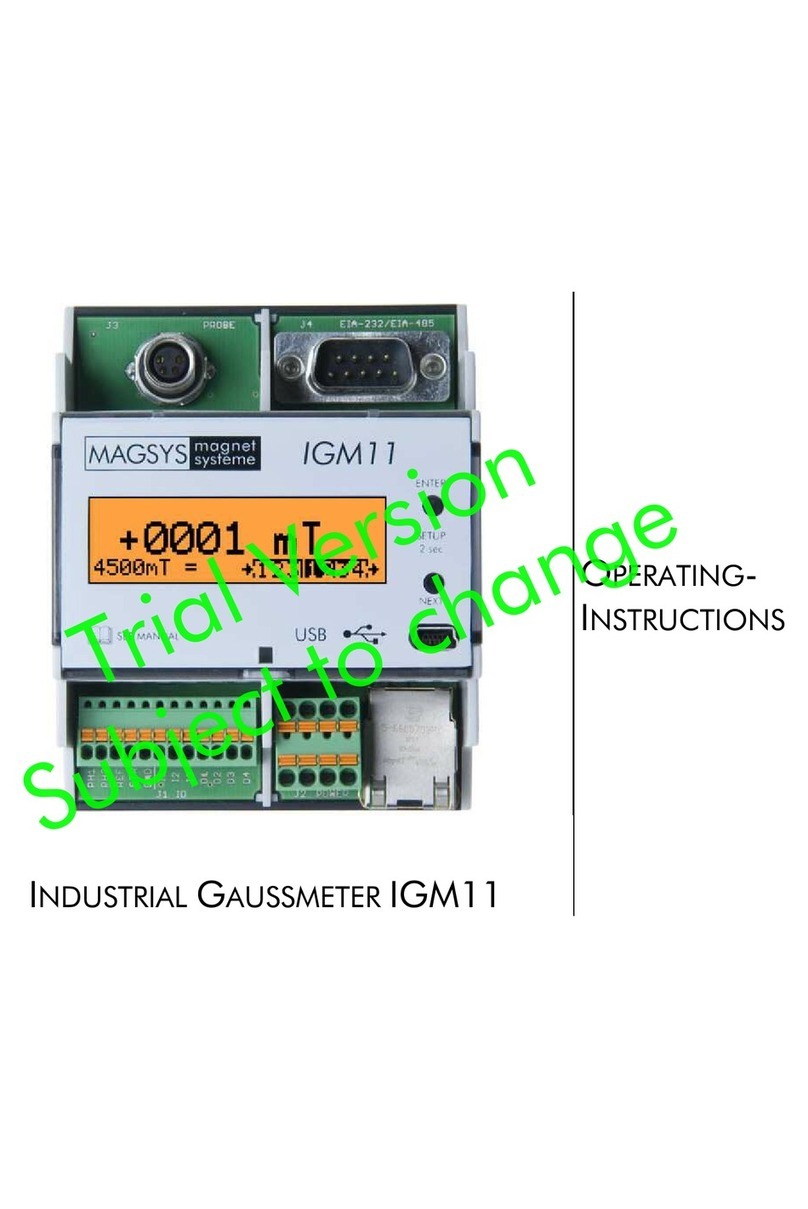
Industrial Gaussmeter IGM11 Operating Instructions
Page 3 / 92
Version 08/2020 © 2020 MAGSYS magnet systeme GmbH -All Rights Reserved
Table of Contents
Safety Instructions 5
Safety Instructions for the Device 5
Safety Instructions for Measuring Probes 5
Safety Symbols 6
Brief Introduction 7
Preparing a Measurement 7
Running a Measurement 7
Measuring Unit 8
Selecting the Measuring Range 8
Display 9
Status Display 9
Function of the Gaussmeter 10
The Hall Effect 10
3.1.1 Linear Properties of the Hall Probe 10
3.1.2 Non-linear Properties of the Hall Probe 11
Measurement Details 13
3.2.1 Sample Measurements with an NdFeB
Magnet 13
3.2.2 Remanence and Hall Gaussmeter
Measurement 14
3.2.3 Accuracy Based on Positioning and
Direction 15
3.2.4 External Static Magnetic Fields 16
Control Elements and Connections 17
Front Panel Overview 17
17
Ports Overview 18
Power Supply 19
Probe Connection 19
USB Interface 20
LAN Interface 21
Operation 23
Buttons 23
Display 24
Status Display 25
Null Balance 25
Measuring Range 25
Measuring Unit 27
DC/AC Field Measurement 27
5.7.1 DC Field Measurement 27
5.7.2 AC Field Measurement 28
Peak Value Measurement 30
5.8.1 Fast Peak Value Detection 30
Probe Data 32
Set-up Menu 33
Reset 33
Settings Overview 33
Settings 34
6.3.1 Overview 34
6.3.2 Measurement 35
6.3.3 Parameters of the Serial Interface EIA-232 36
6.3.4 Parameters of the LAN Interface 36
6.3.5 Settings of the Digital Inputs 37
6.3.6 Settings of the Digital Outputs 38
6.3.7 Settings of the Function Buttons 39
6.3.8 Display of the Error Memory 39
Power Supply Connection 40
Signal Interfaces 41
Introduction 41
Wiring of the Inputs 42
Wiring of the Outputs 43
Serial Interfaces 44
Introduction 44
Connecting the Gaussmeter to an External
Controller 45
EIA-232 Connection 46
9.3.1 Operating Mode SCPI 46
9.3.2 Operating Mode SHORT 47
9.3.3 Operating Mode FLOW 48
Connector Cable EIA-232 48
Samples of Data Transfer EIA-232 49
User Data 51
9.6.1 Character Set 51
9.6.2 Introduction to the SCPI Language 51
9.6.3 SCPI Data Types 53
9.6.4 SCPI Status Model 54
Summary of SCPI Commands 57
9.7.1 Control Commands 57
9.7.2 Main Commands 57
9.7.3 Peak Value Functions 58
9.7.4 Probe Functions 58
9.7.5 Device Functions 58
9.7.6 Memory Functions 59
9.7.7 Serial Interfaces 59
9.7.8 Digital Interfaces 59
SCPI Command Reference 60
9.8.1 Control Commands 60
9.8.2 Main Commands 65
9.8.3 Peak Value Function 68
9.8.4 Probe Functions 70
9.8.5 Memory Functions 72
9.8.6 Device Functions 73
9.8.7 Interface Functions 75
Table of Error Messages 82
Unit Conversion Table 84
Technical Data 85
Declaration of Conformity 89
Warranty and Copyright 90
Index 91




























